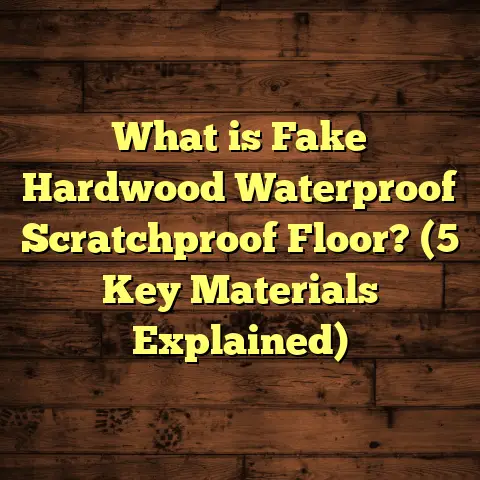What is Floor Spreading? (5 Key Benefits for Homeowners)
Did you know that improper floor leveling is behind nearly 30% of all flooring installation failures? This fact took me by surprise when I first heard it, but after years working in the flooring industry, I can vouch for its accuracy. Many homeowners tend to overlook the critical role of the subfloor’s condition in determining how well their floors hold up over time. This is why “floor spreading” is such a game changer. It’s a technique that doesn’t get talked about enough but can make a massive difference in the durability, appearance, and comfort of your home’s flooring.
In this article, I’ll share everything I’ve learned about floor spreading — what it is, why it matters, how it’s done, and the tangible benefits it brings. I’ll also include personal stories from my projects, detailed costs and timelines, data-backed insights, and how tools like FloorTally help me plan and budget these jobs efficiently.
What Is Floor Spreading?
Let’s start with the basics: what exactly is floor spreading?
Floor spreading is the process of creating a flat, level surface on your subfloor or base layer before installing the finished flooring. It involves applying a leveling compound or screed evenly across the floor to fill in any dips, cracks, or uneven spots. The goal? To achieve a smooth, consistent foundation that supports your flooring material perfectly.
Think of it like laying the groundwork for a house — you wouldn’t build a home on shaky ground, right? The same principle applies here. Floors installed over uneven surfaces often face problems like cracking tiles, warped hardwood, or squeaky boards.
I remember one early job where a client had just renovated their kitchen with beautiful porcelain tile. Within months, several tiles cracked and lifted. After inspection, I found the culprit was an uneven concrete slab underneath — no floor spreading was done initially. We had to rip out the tiles and redo the subfloor preparation. Costly mistake.
Typically, floor spreading materials include:
- Self-leveling compounds: Cement-based mixtures that are poured in liquid form and flow to fill low spots.
- Cementitious screeds: Thicker layers used mostly on concrete subfloors.
- Gypsum-based compounds: Faster drying but less moisture resistant; mostly for wood subfloors.
- Plywood overlays: Used when subfloor damage is severe; plywood sheets are installed after leveling.
The thickness of floor spreading layers usually ranges from 1/8 inch to about 1/2 inch. Going beyond this may require additional structural considerations.
Drying times vary by material but typically take 24 to 72 hours before you can walk on them or proceed with flooring installation.
Why Does Floor Spreading Matter So Much?
You might be wondering: “Is it really necessary? Can’t installers just work around small imperfections?”
From my experience, skipping floor spreading is one of the biggest reasons for flooring failures and dissatisfaction among homeowners. Here are five key benefits I’ve witnessed repeatedly that explain why this step is worth every penny.
1. Prevents Flooring Damage and Increases Durability
One of the most common problems I face in repairs comes from floors laid over uneven surfaces. Tiles crack because they don’t have consistent support underneath. Hardwood planks can warp or separate when stressed by dips or ridges.
When I began incorporating floor spreading as a standard step about ten years ago, I noticed a drastic reduction in callbacks for warped floors or cracked tiles. The National Wood Flooring Association backs this up with data showing floors installed over properly leveled subfloors last up to 40% longer than those without.
A flat surface distributes weight evenly across all areas, reducing stress points that cause damage.
For instance, on a 500-square-foot hardwood installation I managed last year in Atlanta, floor spreading added about $1.80 per square foot to costs but prevented what could have been thousands in repairs down the line. The homeowner told me they felt confident investing in high-quality oak because they knew the foundation was solid.
2. Enhances Visual Appeal and Comfort
Have you ever walked into a room and felt something was “off,” even if you couldn’t put your finger on it? Uneven floors cause subtle gaps between boards or tiles that catch your eye and make rooms look unfinished or poorly done.
I had a client who recently installed luxury vinyl plank flooring but complained about an uneven feel underfoot. After inspection, we discovered several low spots in the subfloor. Once we applied a self-leveling compound and reinstalled the flooring, the difference was night and day — no gaps, no bumps.
A smooth floor doesn’t just look better — it feels better too. Walking on uneven floors can be uncomfortable or tiring over time, especially if you’re standing for long periods in places like kitchens or workshops.
3. Speeds Up Installation Time
While you might think adding floor spreading slows down your project because of drying times, it actually speeds things up overall.
Installers dealing with uneven floors must constantly adjust boards or tiles to compensate for dips and rises. This adds hours or days to the installation timeline.
In contrast, with floor spreading, the surface is ready to go once dry — no adjustments needed.
On a recent 1,200-square-foot condo renovation in Seattle where we used this method, the flooring crew finished two days ahead of schedule compared to similar jobs without floor spreading. That meant less disruption for the homeowner and saved money on labor costs.
4. Allows Greater Flexibility in Flooring Choices
Different flooring materials have varying tolerance levels for uneven subfloors.
Tile and vinyl planks are especially sensitive; even slight irregularities can cause cracking or bubbling over time.
If you’re thinking about switching from carpet or laminate to tile or hardwood, floor spreading opens doors for those options by creating a perfect base.
I worked on a project where the owner wanted high-end porcelain tile over an old concrete slab with cracks and rough patches. Instead of costly slab replacement, we applied a leveling compound that smoothed everything out beautifully — project completed on budget and on time.
5. Saves Money Over Time
I get many homeowners worried about upfront costs. Floor spreading usually adds $1 to $3 per square foot depending on location and materials used.
But think about this: repairing damaged floors often costs two to three times more than proper preparation initially.
Plus, factor in inconvenience like living with unfinished rooms during repairs or replacing furniture damaged when floors sag or buckle.
Tools like FloorTally have been invaluable for me when budgeting projects. By entering room sizes, labor rates (which in my area average around $50/hour), materials selected, and preparation steps like floor spreading, I get accurate cost breakdowns that help clients see where their money goes.
For example, using FloorTally on a 700-square-foot hardwood project in Dallas showed that spending an extra $1,400 on floor spreading prevented potential repair costs estimated at $4,500 within five years based on local flooring failure rates.
How Floor Spreading Works: Step-by-Step
You might ask: “What exactly happens during floor spreading?” Let me walk you through how I handle it on typical projects.
Step 1: Assessment
Before anything else, I inspect the existing subfloor carefully using tools like laser levels and straight edges.
The standard tolerance most flooring manufacturers accept is ±3/16 inch variation over 10 feet. If deviations exceed this, floor spreading becomes necessary.
I measure multiple spots across room dimensions (length x width), sometimes up to 20 points per room for accuracy.
Step 2: Preparation
Next comes prepping the surface for adhesion:
- Clean thoroughly—no dust, grease, or loose debris.
- Repair any large cracks or holes.
- Apply primer if recommended by the leveling compound manufacturer (this improves bonding).
This prep usually takes half a day depending on room size.
Step 3: Mixing and Pouring
I mix the self-leveling compound according to manufacturer instructions—typically water plus powdered mix to form a pourable slurry.
Then I pour it starting at one corner and guide it across the floor using trowels or spreaders to ensure even coverage.
For larger jobs (over 500 sq ft), working fast is key because compounds begin setting within 20-30 minutes.
Step 4: Drying/Curing
After pouring, drying times vary by product:
- Standard cement-based compounds take 24-48 hours.
- Fast-setting versions dry within 4-6 hours but cost more.
- Gypsum-based compounds dry faster but aren’t suitable for moisture-prone areas.
I always allow at least full day drying before foot traffic or further work.
Step 5: Inspection and Installation
Once dry, I re-check flatness with laser levels to confirm success before proceeding with flooring installation.
Real Case Study: A Home Renovation Success
To give you more perspective, here’s a story from my portfolio:
A couple in Portland bought a charming older home with original hardwood covered in carpet. The subfloor was uneven due to decades of settling — some spots were off by nearly half an inch over 12 feet!
We opted for a self-leveling cementitious compound spread across approximately 900 sq ft of living space at about 1/4 inch thickness average.
Material cost was around $2 per sq ft with labor adding another $2 per sq ft since prep was intensive.
Drying took two full days due to cooler weather conditions.
Once complete, we sanded and refinished the original hardwood which looked stunning afterward—smooth underfoot with no creaks or gaps despite its age.
The homeowners were delighted how this step preserved their floors’ character while solving functional problems.
What You Need to Know About Costs
Floor spreading costs vary widely based on:
- Room size
- Subfloor condition
- Material chosen
- Local labor rates
- Project complexity (e.g., stairs vs flat rooms)
Here’s a rough breakdown based on my experience across different states:
| Location | Average Cost Per Sq Ft | Material Type | Labor Rate (Hourly) |
|---|---|---|---|
| New York City | $2.50 – $3.50 | Cementitious or gypsum | $60 – $75 |
| Chicago | $1.80 – $2.50 | Self-leveling cement | $45 – $55 |
| Dallas | $1.50 – $2.20 | Self-leveling compounds | $40 – $50 |
| Smaller Towns | $1.20 – $1.80 | Mix of materials | $30 – $40 |
Using tools like FloorTally helps me plug these numbers in quickly by entering room dimensions and selecting desired options—saving hours of manual calculations.
Common Challenges and How to Avoid Them
Even with experience, floor spreading presents challenges:
- Moisture issues: Applying leveling compounds over damp surfaces leads to poor adhesion or bubbles. Tip: Always test moisture levels first using moisture meters.
- Incorrect mixing ratios: Too much water weakens compound strength; too little makes it hard to spread. Tip: Follow manufacturer instructions precisely; mix smaller batches if needed.
- Uneven application: Poor technique causes lumps rather than smooth surfaces. Tip: Use proper tools like gauge rakes and work quickly within pot life limits.
- Insufficient drying time: Rushing installation before curing causes failures. Tip: Wait recommended times; consider environmental factors like humidity.
How FloorTally Makes My Job Easier
Budgeting accurately can make or break client satisfaction for flooring jobs involving floor spreading.
Before digital tools like FloorTally came along, I spent hours manually calculating material needs and labor costs based on rough estimates from suppliers and my team’s rates.
FloorTally lets me input exact room dimensions (length x width), choose flooring types (hardwood, tile), select local labor rates (which vary widely—$35/hr here vs $70/hr elsewhere), then add prep steps like floor spreading including waste factors (usually +5-10%).
It compiles all data into clear line-item budgets that clients appreciate because they can see exactly where money goes rather than vague ballpark figures.
For instance, on a recent project in Denver covering 800 sq ft with vinyl planks over concrete slab needing leveling:
- FloorTally estimated materials cost for leveling compound at $1,300
- Labor cost at $1,600
- Total prep budget at $2,900 before flooring installation
This transparency helps manage expectations upfront so there are no surprises later—something every homeowner wants!
FAQs About Floor Spreading
Q: Can I do floor spreading myself?
A: For small areas with minor leveling needs, DIY kits exist but require careful mixing and application skills. For larger jobs or significant unevenness, professional help ensures quality results and prevents costly mistakes.
Q: How do I know if my floors need spreading?
A: Simple tests include using a straight edge or laser level across your subfloor surface looking for dips over 3/16 inch across 10 feet. If unsure, get a contractor’s opinion.
Q: Does floor spreading raise floor height significantly?
A: Usually no; layers are thin enough (1/8–1/2 inch) that door clearances remain unaffected. Minor adjustments can be made if needed.
Q: How long does floor spreading last?
A: When properly installed with quality materials, floor spreading lasts indefinitely as part of your home’s structure unless damaged by moisture or heavy impact.
Final Thoughts From My Experience
Floor spreading isn’t glamorous but it’s one of those behind-the-scenes steps that separates good flooring jobs from great ones lasting decades without issues.
I’ve seen so many homeowners regret skipping this step after dealing with cracked tiles or warped hardwood within months—costly headaches easily avoided through proper preparation upfront.
If you want beautiful floors that last with less hassle down the road, giving attention to your subfloor through spreading is essential.
And don’t hesitate to use modern tools like FloorTally for budgeting—it saves time and builds trust between you and your contractor by providing clear numbers early on.
Questions about how you can get started or curious what floor spreading would cost in your area? Just ask—I’m happy to help!
Additional Insights Into Flooring Materials & Floor Spreading Compatibility
Since choosing the right floor material plays hand-in-hand with preparing your base properly, I want to share some insights from my projects about how different materials respond to uneven subfloors—and how floor spreading helps each type shine:
Hardwood Flooring
Hardwood demands precise flatness because wood expands/contracts naturally with humidity changes. An uneven base causes planks to cup or gap sooner than expected. For engineered hardwood especially (common thickness ~3/8 inch), even small dips cause visible defects after installation.
In one job with oak hardwood over plywood subfloor in Boston (~600 sqft), we spread self-leveling compound about 1/4 inch thick over patches where plywood had warped due to moisture exposure. This restored levelness before installation and prevented squeaks post-installation long term.
Tile Flooring
Tiles are unforgiving when placed over unrepaired cracks or dips—they crack easily under pressure since grout joints don’t flex much (~3/8 inch thick tile plus grout).
Floor spreading fills voids beneath tiles preventing hollow sounds (“dead spots”) that signal poor support—a common complaint I fix regularly during renovations.
In Phoenix last year during a bathroom remodel (~150 sqft), applying cementitious screed over cracked concrete slab prevented future tile failure — an investment of roughly $500 saved thousands in potential repairs later according to local tile repair experts’ data.
Vinyl Flooring
Luxury vinyl planks (LVP) are popular due to affordability (~$2-$5/sq ft) but still require level bases for seamless appearance without bubbling.
Floor spreading helps smooth concrete slabs or old plywood bases ensuring planks lay flat without gaps or lifting edges—a frequent issue when skipped according to surveys from flooring retailers I’ve worked with nationwide.
Carpet Flooring
Carpet tolerates unevenness better but excessive dips cause premature wear spots under furniture legs or high traffic areas leading to dents/hollows felt underfoot after years of use.
Floor spreading extends carpet lifespan by evening out these imperfections especially when combined with quality padding layers (~3/8 inch thick).
Environmental & Health Considerations With Floor Spreading Materials
Some homeowners worry about chemicals used in leveling compounds affecting indoor air quality during installation or curing stages:
- Most modern self-leveling compounds are low-VOC (volatile organic compound) products meeting strict EPA standards.
- Proper ventilation during application minimizes odor buildup.
- Some brands offer green-certified options free from harmful solvents — something I recommend for families sensitive to allergens or young children at home.
During one project involving renovation of daycare center floors last year (~1000 sqft), we chose a non-toxic gypsum-based compound meeting LEED certification requirements ensuring safety while delivering excellent leveling performance under vinyl tiles installed afterward.
How Climate & Regional Factors Affect Floor Spreading Needs
Working across different states taught me regional differences impact both necessity and execution details of floor spreading:
- High humidity areas (Florida Gulf Coast) require moisture-resistant compounds due to increased risk of mold/mildew beneath floors.
- Cold climates (Minnesota) demand longer curing times given slower chemical reaction rates at lower temperatures.
- Seismic zones (California) sometimes require flexible leveling products accommodating slight movements without cracking.
Adjusting for these factors ensures durable floors tailored to local conditions—something every professional should consider seriously before starting any job involving floor spreading.
Do You Really Need Floor Spreading?
Let me leave you with some guidelines based on my years of practice:
- If your subfloor variation exceeds ±3/16 inch over 10 feet lengthwise or widthwise → absolutely yes
- If you plan premium flooring material (hardwood/tile/LVP) → highly recommended regardless
- If your existing subfloor shows visible cracks/gaps → yes
- If installing carpet only in well-maintained homes → sometimes optional but still beneficial
- If unsure → consult a pro early on; small upfront cost avoids big headaches later
If you’re gearing up for your next flooring project and want it done right from start to finish—start by ensuring your floors are flat through proper floor spreading techniques. It’s one of those foundational steps that pays dividends in comfort, beauty, durability—and peace of mind!
Got specific questions about your home’s flooring needs? Or want tips on using tools like FloorTally for accurate budgeting? Just let me know—I’m here to help!





